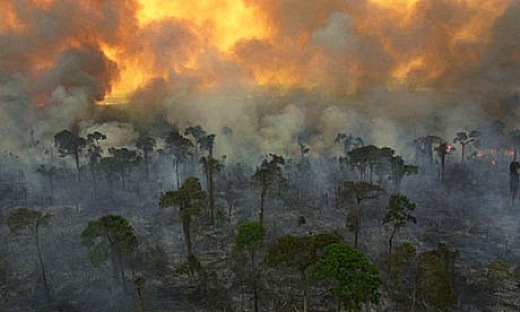Climate
The Amazon supports the most luxurious and various environments on earth because of its climate. Since it is located by the equator, the humidity is high during the day and cooling occurs at night causing early morning radiation fogs form and heavy dew drips. High sun angles and low latitude location make for annual temperatures with little seasonal differentiation; colossal precipitation is experienced in all months. Estimates show over 80 inches of precipitation falls annually.
Thunderstorms
The moisture from the heavy rain and the unstable air caused from the warm air that rises rapidly from the lift from fronts, or sea breezes, creates thunderstorms year long in the Amazon Rainforest. On the other side of the Amazon, the mountains are also capable of lifting air to form thunderstorms. These thunderstorms can cause extensive damage in the rainforest from tree falls. The falling air touches the water, the warm air rises and creates high winds and hurricanes that toss around trees. When one tree falls, it creates a domino effect and dozens of neighboring trees are brought down with it. Larger tropical storms can cause substantial damage and recovery may take a decade to centuries. Hurricane Hugo (1989) is expected to take at least 250 years.
Pressure & Winds
Rainforests are wet because the air pressure at the equator is low. Low air pressure also means that air rises into the atmosphere. As result, the sun evaporates moisture from the forest, producing storms on a daily basis.
Ocean Circulation
During El Nino the increase of rising air over warm water leads to the increase in atmospheric pressure in the Amazon. And in the ENSO cycle means pressures flip-flop in the Walker Circulation and the warm water goes to South America. As well as 22-24% of rainfall in the tropics result to higher sea surfaces and more vegetation growth.
The percentage difference from average rainfall levels during the strong 1997-
1998 El Niño event. The December, January, and February mean is on the left,
and the March, April, May mean is on the right. Image Courtesy of NOAA:
Climate Prediction Center.
References:
Picture reference:



Great job on your blog guys. I liked how everything flowed so nicely. First was moisture then rain then thunderstorms. You transitioned between forms really well. It's sad to see the rain forest being destroyed by the hurricanes. I like the picture with the explosion in the background, but how did that happen? If you could explain those pictures with captions that would be great. One thing you could have done to further perfect your blog was to explain how these processes affect people.
ReplyDeleteHello guys! I like that the structure of your blog makes it easy to follow. There was definitely a good flow between topics; but, I'm not sure I understood your explanation on the ocean circulation nor did you tell me how these conditions affect the people that live in the rain forest. Also, the pictures are nice but I think a little captioning would really enhance the blog. Good luck!
ReplyDeleteBeautiful area for discussion! I think you structured your blog nicely but could have done more to relate the pictures to your content, captions are a good means of doing that. Also I would resize the map so more detail could be seen, and perhaps do the caption in your own words! All in all it was pleasant and flowed well. - I love the amazon and wish more was done to protect it and educate the public to it's importance.
ReplyDelete